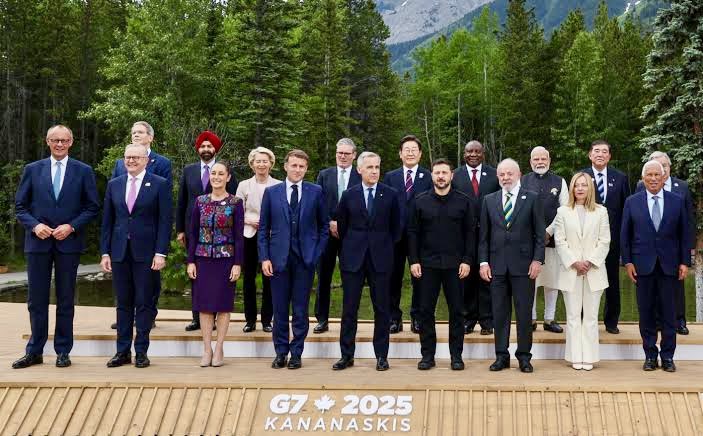The G7) Summit is one of the most prominent annual gatherings of world leaders, bringing together heads of state or government from seven of the world’s most advanced economies to address pressing global challenges. Comprising Canada, France, Germany, Italy, Japan, the United Kingdom, and the United States, with the European Union as a non-enumerated member, the G7 serves as a platform for dialogue on economic policy, international security, climate change, global health, and more. This article explores the origins, evolution, objectives, and impact of the G7 Summit, with a focus on its role in shaping global governance in an increasingly complex world.
Origins and Evolution of the G7
The G7 was born in the 1970s amid economic turbulence caused by the 1973 oil crisis and subsequent global economic instability. The first informal meeting, known as the Group of Six (G6), took place in 1975 at the Château de Rambouillet in France, initiated by French President Valéry Giscard d’Estaing and German Chancellor Helmut Schmidt. The original members—France, Germany, Italy, Japan, the United Kingdom, and the United States—sought to coordinate economic policies to address inflation, unemployment, and the energy crisis.
In 1976, Canada joined the group, forming the G7. The European Union was granted representation in 1977, participating in discussions without being counted as a formal member. Russia joined in 1998, transforming the group into the G8, but its membership was suspended in 2014 following its annexation of Crimea and was formally ended in 2017. Since then, the G7 has reverted to its original composition, focusing on democratic values and shared economic interests.
The G7 Summit has evolved from an economic-focused forum into a broader platform addressing global issues, including climate change, terrorism, global health crises, and geopolitical tensions. Its informal structure allows for candid discussions, fostering consensus-driven solutions among leaders of like-minded nations.
Structure and Functioning of the G7 Summit
The G7 Summit is held annually, hosted on a rotating basis by one of the member countries. The host nation sets the agenda, often reflecting its priorities and pressing global issues. The summit typically spans two to three days and includes formal meetings, bilateral discussions, and informal interactions among leaders. In addition to heads of state or government, finance ministers, foreign ministers, and other key officials often hold preparatory meetings throughout the year to lay the groundwork for summit discussions.
The G7 operates without a permanent secretariat or headquarters, emphasizing its informal nature. Decisions are non-binding, relying on the political will of member states to implement agreements. The European Union’s participation ensures alignment with broader European policies, while guest countries or organizations (e.g., the African Union, International Monetary Fund, or United Nations) are often invited to address specific issues.
Key features of the G7 Summit include:
- Leaders’ Summit: The main event where heads of state or government discuss high-level issues and issue a joint communiqué outlining commitments.
- Ministerial Meetings: Sector-specific meetings (e.g., finance, environment, foreign affairs) held throughout the year to advance technical discussions.
- Engagement Groups: Non-governmental groups, such as the Business 7 (B7), Youth 7 (Y7), and Civil Society 7 (C7), provide recommendations to influence G7 priorities.
Key Issues Addressed at G7 Summits
The G7 Summit tackles a wide range of global challenges, reflecting the interconnected nature of modern geopolitics. While economic coordination remains a core focus, recent summits have prioritized issues such as:
- Climate Change and Sustainability: The G7 has increasingly emphasized environmental action, with commitments to reduce carbon emissions, transition to renewable energy, and support climate finance for developing nations. The 2021 G7 Summit in the UK, for instance, saw pledges to phase out coal-fired power and achieve net-zero emissions by 2050.
- Global Health: The COVID-19 pandemic brought health security to the forefront. The G7 played a key role in promoting vaccine equity through initiatives like COVAX and addressing pandemic preparedness. The 2021 Carbis Bay Summit committed to distributing 1 billion vaccine doses globally.
- Geopolitical Stability: The G7 addresses conflicts and security threats, such as Russia’s invasion of Ukraine. The 2022 G7 Summit in Germany focused heavily on sanctions against Russia, support for Ukraine, and mitigating the global food and energy crises triggered by the conflict.
- Economic Resilience: From trade disputes to supply chain disruptions, the G7 seeks to stabilize the global economy. Recent summits have addressed inflation, digital transformation, and the economic impacts of sanctions.
- Inequality and Development: The G7 promotes inclusive growth, gender equality, and support for developing nations. The Partnership for Global Infrastructure and Investment (PGII), launched in 2022, aims to counter China’s Belt and Road Initiative by funding sustainable infrastructure in low- and middle-income countries.
The 2025 G7 Summit: A Look Ahead
The 2025 G7 Summit, hosted by Canada in Kananaskis, Alberta, from June 9–11, marks a return to a venue that previously hosted the event in 2002. Canada’s agenda is expected to focus on climate change, economic security, and support for Ukraine, building on discussions from the 2024 summit in Italy. Prime Minister Justin Trudeau has emphasized strengthening democratic resilience, addressing misinformation, and promoting sustainable development. The inclusion of Pope Francis as a guest—the first time a pontiff has attended a G7 Summit—underscores the focus on ethical governance and social justice.
Key anticipated topics for 2025 include:
- Climate Financing: Enhancing support for vulnerable nations facing climate impacts.
- Artificial Intelligence: Building on the G7’s Hiroshima AI Process, leaders will likely discuss ethical AI development and regulation.
- Global Security: Continued support for Ukraine and strategies to counter authoritarian influence.
- Economic Recovery: Addressing inflation, supply chain challenges, and energy transitions.
Achievements and Criticisms
The G7 Summit has driven significant global initiatives. Notable achievements include debt relief for heavily indebted poor countries in the 1990s, the Global Fund to Fight AIDS, Tuberculosis, and Malaria in 2002, and commitments to combat climate change through the Paris Agreement. The G7’s ability to coordinate rapid responses, such as sanctions against Russia or vaccine distribution during COVID-19, highlights its influence.
However, the G7 faces criticism for its exclusivity and perceived elitism. Critics argue that it represents a narrow group of wealthy nations, sidelining emerging economies like China, India, and Brazil, which play critical roles in global affairs. The non-binding nature of G7 commitments often leads to accusations of insufficient follow-through. Additionally, protests at summit venues frequently highlight concerns about globalization, inequality, and environmental inaction.
The G7 in a Multipolar World
As the global order shifts toward multipolarity, the G7’s relevance is both challenged and reaffirmed. The rise of the G20, which includes emerging economies, has broadened global governance discussions, but the G7’s smaller, values-based format allows for more cohesive decision-making among democratic allies. Its ability to adapt to new challenges—like digital governance, AI ethics, and hybrid threats—will determine its future influence.
The G7 also navigates tensions within its membership. Differing priorities, such as trade policies under former U.S. President Donald Trump or divergent approaches to China, have occasionally strained unity. Yet, the G7’s strength lies in its ability to foster dialogue and consensus among leaders who share democratic principles and economic interdependence.
Conclusion
The G7 Summit remains a cornerstone of global diplomacy, offering a space for leaders to address interconnected challenges through collaboration. While its informal structure and limited membership spark debate, its ability to set agendas and mobilize resources underscores its enduring significance. As the world faces unprecedented challenges—from climate crises to geopolitical conflicts—the 2025 G7 Summit in Canada will test the group’s capacity to lead with unity and purpose. By balancing its traditional economic focus with emerging issues like AI and global equity, the G7 can continue to shape a more resilient and inclusive world order.
This article provides a thorough overview about the G7 Summit and suitable for the readers, if needs more information Please visit official website https://www.g7italy.it/















Leave a Reply